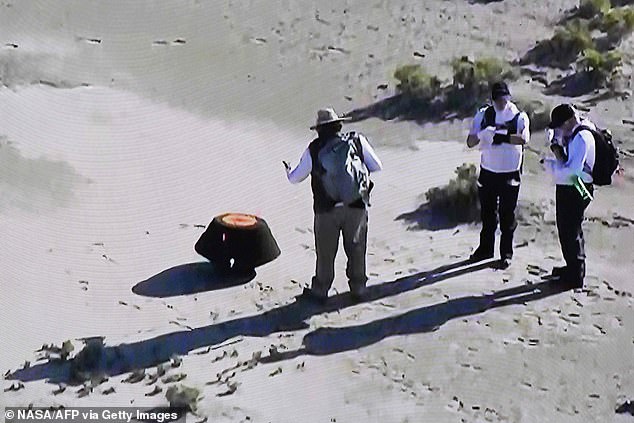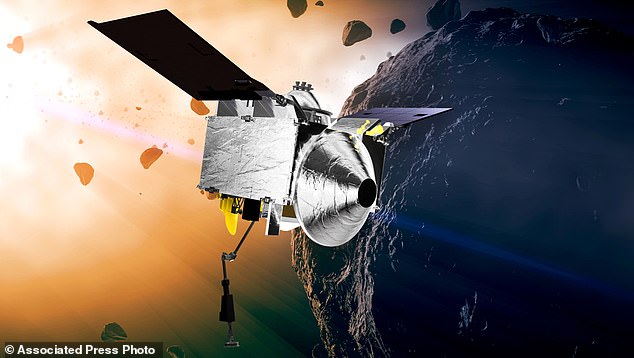NASA’s first asteroid samples land on Earth in stunning live video after release from spacecraft – SEVEN years after $1Billion OSIRIS-REx launch
NASA scientists shouted with joy as they watched a parachute deliver their first samples of material from a world beyond the moon.
The Osiris-Rex spacecraft dropped the bowl-shaped container of debris from the Bennu asteroid at the edge of Earth’s atmosphere before departing for its next target.
Scientists cautiously approached the capsule after it came to rest in the Utah desert on Sunday, tested the nearby air for alien contaminants and flew it by helicopter to a nearby Defense Department facility.
Seven years after launch, NASA said the “real moment of truth” will come when they open the 4.5 billion-year-old contents at NASA’s Johnson Space Center in Houston in the coming days.
“We’re going back to the beginning of the solar system, looking for clues as to why Earth is a habitable world, this rare jewel in space with oceans and a protective atmosphere,” said lead scientist Dante. Lauretta from the University of Arizona.
The capsule came to rest in the Utah desert on Sunday morning after being dropped by parachute

NASA scientists had to test the nearby air and soil for alien contaminants before touching the capsule
“The biggest question is the origin of life, and we believe we’re bringing back that kind of material, perhaps the seeds of life that these asteroids delivered in the beginning.”
Japan, the only other country to return asteroid samples, collected about a teaspoon during a few asteroid missions.
The pebbles and dust The goods delivered on Sunday represent the largest cargo from beyond the moon. The samples are preserved building blocks from the beginning of our solar system 4.5 billion years ago and will help scientists better understand how Earth and life emerged.
Osiris-Rex, the mothership, flew off in 2016 for the $1 billion mission. It reached Bennu two years later, and in 2020 it picked debris from the small, round space rock using a long-handled vacuum cleaner. By the time it returned, the spacecraft had logged 4 billion miles (6.2 billion kilometers).
NASA’s recovery efforts in Utah include both helicopters and a temporary cleanroom at the Department of Defense’s Utah Test and Training Range. The samples will be flown to a new laboratory at NASA’s Johnson Space Center in Houston on Monday morning. The building already houses hundreds of pounds (kilograms). moon rocks collected by the Apollo astronauts over half a century ago.
The mission’s lead scientist, Dante Lauretta of the University of Arizona, will accompany the samples to Texas. The opening of the container in Houston in a few days will be “the real moment of truth” given the uncertainty over the quantity inside, he said before landing.
Engineers estimate that the canister contains 250 grams of material from Bennu, plus or minus 100 grams (plus or minus 3.53 ounces). Even at the low end, it will easily exceed the mission’s minimum requirement, Lauretta said.
It will take a few weeks to get an accurate measurement, NASA chief curator Nicole Lunning said.
NASA plans a public show-and-tell in October.

NASA’s first samples of asteroids retrieved from deep space were dropped into the Utah desert on Sunday, capping a seven-year journey.

During a flyby of Earth, the Osiris-Rex spacecraft released the sample capsule from a distance of 100,000 kilometers.
Bennu currently orbits the sun, 81 million kilometers from Earth, and is about a third of a mile (half a kilometer) in diameter, about the size of the Empire State Building, but shaped like a spinning top. It is believed to be a broken fragment of a much larger asteroid.
During a two-year investigation, Osiris-Rex discovered that Bennu was a thick mess full of boulders and craters. The surface was so loose that the spacecraft’s vacuum arm sank half a meter into the asteroid, sucking in more material than expected and causing the lid to jam.
These close-up observations could be useful late in the next century. Well, yes expect to get dangerously close to Earth in 2182 – possibly close enough to hit. The data collected by Osiris-Rex will help in any asteroid deflection attempt, according to Lauretta.
Osiris-Rex is already chasing the asteroid Apophis and will reach it in 2029.
This was NASA’s third sample to return from a robotic mission in space. The Genesis spacecraft dropped bits of solar wind in 2004, but the samples were degraded when the parachute failed and the capsule crashed to the ground. The Stardust spacecraft successfully delivered comet dust in 2006.
NASA’s plans to return samples from Mars have been put on hold after an independent review board criticized the cost and complexity. Over the past two years, the Mars rover Perseverance has collected nuclear samples for possible transport to Earth.
